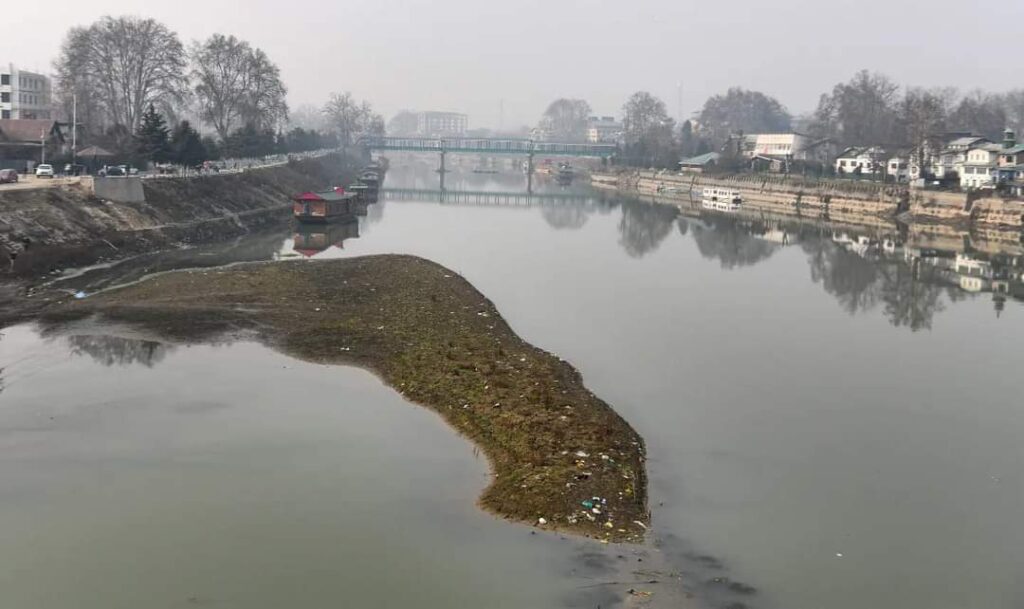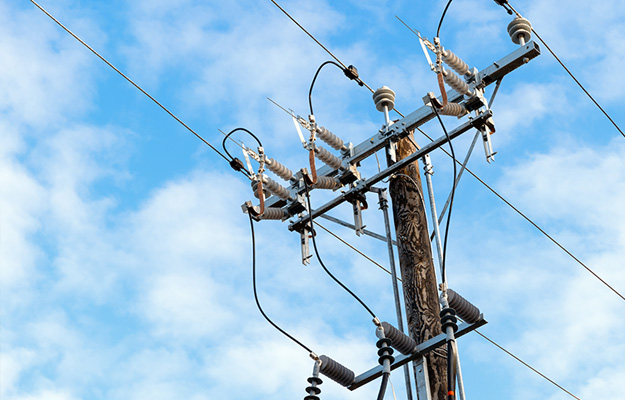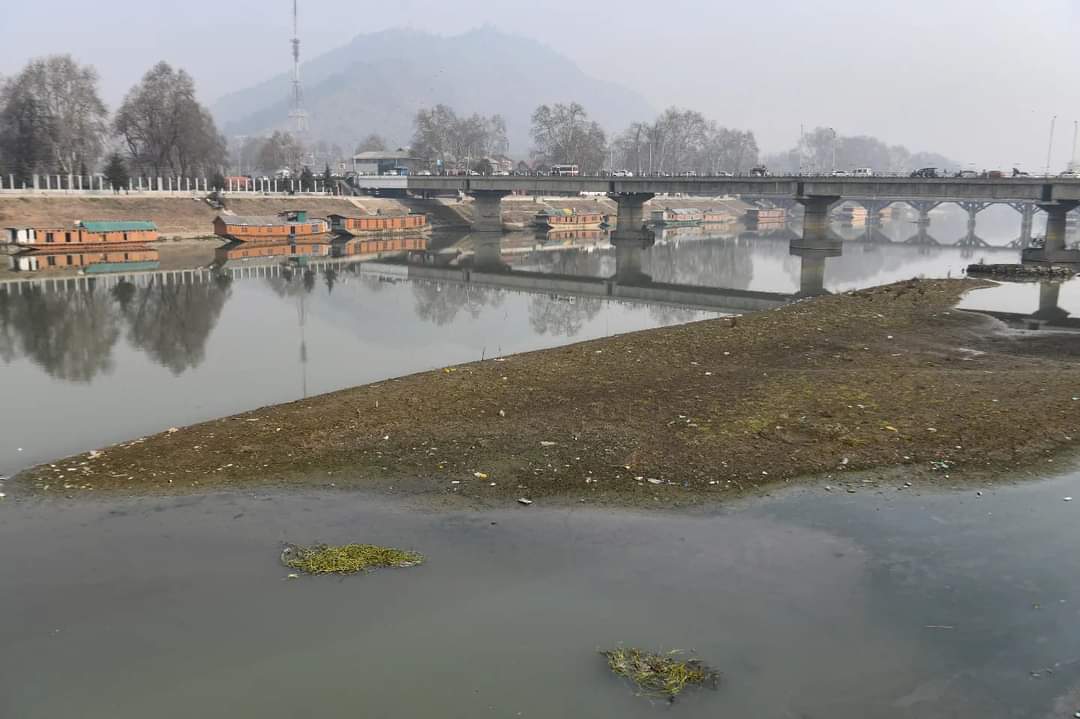In the grip of an unusual and enduring dry spell, Kashmir faces a multi-faceted crisis affecting agriculture, tourism, and essential water resources. As temperatures soar and rivers hit historic lows, the region braces for unprecedented challenges.
By Tauheed Ahmad
The pervasive and prolonged dry spell in the Kashmir Valley is unleashing a cascade of concerns, impacting various sectors including agriculture, horticulture, tourism, and water resources, and posing threats to the region’s ecological balance. As the unusual absence of rain or snow persists, experts are sounding alarms across diverse domains, including agriculture, the main backbone of the region’s economy.
The absence of active Western Disturbances has resulted in decreased moisture levels, impacting rivers and water sources essential for agriculture. This situation raises concerns about irrigation capabilities, crop yields, and overall agricultural productivity, amplifying the hardships for the local populace.
Syed Intikhab, Agriculture Extension Officer at B.K Pora, Budgam highlights the concerning impact of rising temperatures on agriculture. He emphasizes, “Agriculture is based on its own time period, and any deviation in temperature can directly affect crops and production. This isn’t limited to agriculture alone; horticulture, more susceptible to temperature variations in winter, faces adverse effects. Premature temperature rise alters plant behavior, leading to reduced yields. Additionally, the decline in the water table further compounds challenges, impacting overall sector dynamics.”
A concerned farmer in Bugam village of Budgam expresses the distress caused by the uncharacteristic rise in temperatures during this usually harsh winter period. He shares, “The absence of snowfall, which is typical during this season, has impacted our sector significantly. In winter, we traditionally sow seeds in polyhouses. However, the unusually high temperatures have led to a rise in the polyhouse temperature, damaging our saplings. Moreover, the irrigation department, in the past, would caution us about paddy cultivation in low-snowfall years due to potential water scarcity. This year, with almost no snow or rain throughout winter, we anticipate receiving such notices early on.”
Hilda Shafi, Assistant Executive Engineer at the Irrigation Sub Division Chattergam, under the Pampore Division, plays a pivotal role in sustaining the agricultural landscape of Budgam district, expresses concern over the ongoing dry spell, highlighting potential adverse effects on the overall functioning of the irrigation scheme. She says “I see a direct correlation between the ongoing dry spell and the potential damage it could inflict on agricultural produce, which is fully dependent on the lift irrigation scheme, with ramifications reaching various aspects of the local economy”.
Currently, the department is actively examining the situation, and as of now, we have not received any directives to issue notices urging the public to opt for crops resilient to dry weather conditions. I remain hopeful that the coming or final stages of this winter period may bring some respite, alleviating the impact on our crucial agricultural activities, she added.
Pertinently, the lift irrigation scheme is crucial for sustaining agricultural excellence in Budgam district’s villages like Bugam, Dooniwari, and Wathoora. Spanning thousands of hectares, these areas, relying on water sourced from the Jhelum River in Pulwama’s Marval area, cultivate a diverse range of vegetables. Bugam, known as ‘Chotaa Punjab,’ is a renowned supplier of vegetables, not only meeting local demand but also exporting to northern Indian states, including Delhi, UttarPradesh and Haryana.
Bugaam Batpora, a small hamlet, has emerged as a leading vegetable-producing village in the Kashmir valley, symbolizing the agricultural richness and economic contribution of the region.
In response to the persistent dry spell in the Kashmir valley, SKUAST-K issues a crucial advisory for farmers and orchardists, emphasizing tailored measures to navigate the unique challenges presented by the current weather conditions. The advisory underscores the importance of strategic practices for orchards and field crops, providing specific guidelines for Apple, Almond, and Apricot orchards, as well as general field crop management.
“For Apple, Almond, and Apricot orchards, we strongly recommend avoiding pruning during this dry spell to prevent freezing injury and untimely sprouting. Additionally, refraining from irrigation is advised to mitigate the risk of root damage. The emphasis is on orchard sanitation, including the thorough removal and burial of twigs and fruits. Thinning of brown sarsoon, mulching, field sanitation, and the installation of yellow sticky traps are suggested practices for field crops,” states the advisory.

To address potential vegetable crop damage, the advisory highlights the necessity of maintaining weed-free conditions in standing crops, coupled with surface scrapping for enhanced aeration and moisture conservation. Shallow irrigation is recommended judiciously, only if critically needed and during daylight hours.
Survival Tactics
In a bizarre twist of necessity, Abid Rather from Shopian sheds light on the unusual lengths farmers went to for survival, remarking, “Last year, the valley experienced a shortage of snowfall, but some relief came in February. In fact some apple orchard owners in Shopian resorted to a peculiar solution — stealing snow from neighboring orchards to water their apple trees. If these conditions seem unusual already, one can only fathom the challenges farmers face this year with the persistent dry spell.”
Warmth Unleashed
Srinagar registers the 6th hottest January day in 132 years at 15.0°C, marking unusual warmth. Historical data reveals the last such temperature was recorded in 2010 at 15.8°C. Other regions in Kashmir, including Qazigund and Pahalgam, also break records with Qazigund hitting the hottest January day in 14 years at 15.8°C, and Pahalgam reaching 13.1°C, the warmest in six years.
Night temperatures improve, settling above freezing point at 0.2°C after almost a month. The dry weather is expected to persist until January 23, with a chance of light snow on isolated higher reaches on January 16 and 20.
Dry Spell Dilemma
Experts suggest that the prolonged dry weather signifies a shift in the precipitation regime. While human interference is acknowledged, the natural magnitude of change is considered high. The dry spell this year is deemed unrelated to the El Niño effect, emphasizing the complexity of factors influencing the region’s climate.
As the Jhelum River hits historic lows, the water levels at Sangam and Asham reach all-time lows. The unprecedented dry spell is reshaping the landscape, affecting water bodies crucial for various sectors.
The overall dry spell, affecting water bodies, has implications for the region’s hydrological cycle, posing challenges for sustainable water management. Dr. Suhail A. Bandh, Assistant Professor of Environmental Science, emphasizes the stress on Kashmir’s lakes and rivers as reduced precipitation and faster evaporation rates cause water levels to drop, impacting aquatic ecosystems and threatening flora and wildlife.
The profound shift in the precipitation regime, as noted by experts, raises concerns across the board. Dr. Muhammad Muslim, Assistant Professor at Kashmir University’s Environmental Sciences department, indicates that climate change is evident, with a noticeable decrease in precipitation and a shift in the timing of winter precipitation.
However, the repercussions of the dry spell extend beyond. Experts warn of potential acute water shortages in the summer, creating ripple effects on ecosystems, agriculture, and livelihoods. Professor Shakil A Romshoo, a glaciologist and climate change researcher, expresses concern over below-average snowfall and the extended dry spell, potentially leading to low water levels in the valley’s water bodies.
In a dire development, the Jal Shakti department has sounded the alarm in Kashmir as the region grapples with historically low water levels in its bodies due to a prolonged dry spell. Chief Engineer Sanjeev Malhotra stresses the critical need for a wet spell to replenish water sources and urges the public to use water judiciously.

“To address the looming crisis, portable water supply tankers are on high alert. The situation is particularly concerning in North and central Kashmir, where water shortage complaints are on the rise, posing unprecedented challenges to historically abundant water sources like lakes and rivers”, he said.
Mudabbir Ahmad from Rangreth raises a crucial concern, stating, “Drinking water has become a major casualty this winter. After discussions with officials, it’s evident that they are equally helpless due to the scarcity of water sources. Rivers, the primary water source, are dwindling rapidly, with the severe dry spell persisting since September.”
Upcoming Weather Forecast
Director of the Meteorological Department in Srinagar states, ‘In the coming days, indications are that the weather will take a turn after January 25th, where rain and snowfall are likely”.
The impact of El Niño on Kashmir’s climate has historical precedence. In 2014, 2015, and 2018, winter months witnessed extended dry spells, and the current situation aligns with these patterns, he added.
Health Implications of Prolonged Dry Spell
Dr. Arshad Hussain Wani, a Medical Officer in J&K Health Services, underscores the potential health implications associated with the ongoing prolonged dry spell. While discussing the current weather conditions, he states, “If the dry spell persists and we do not experience snowfall, it could have serious consequences for public health. The absence of snowfall, which typically contributes to environmental cleansing, might impact the ecological balance.”
Dr. Wani further highlights the connection between climate conditions and health, stating, “Many germs and bacteria thrive in specific environmental conditions. The protective layer usually provided by snowfall is absent, potentially allowing certain pathogens to persist in the environment. This, coupled with the altered climatic conditions, could contribute to changes in disease dynamics.”
Drying up of Wular Lake
The renowned Wular Lake, once a source of livelihood for nearly 10,000 fishermen families in North Kashmir, is now facing a dire threat to its existence. Approximately half of the lake has dried up due to the prolonged dry spell in the Valley.
Local fishermen from villages like Kehne Usa, Zurimanz, Ashtangoo, Lankrishipora, Laharwalpora, and Kulhama, who traditionally extracted water chestnuts during winters, are now grappling with a significantly reduced water level.
The diminishing lake has severely impacted the livelihoods of these communities, forcing them to seek alternative sources of income. The absence of snow on surrounding mountains and increasing sewage in the lake compound the challenges, further endangering both the fishermen’s livelihoods and aquatic species. Urgent measures are called for to address the environmental degradation and ensure the survival of Wular Lake, a vital resource for the region. This information was reported by the news agency Kashmir News Observer (KNO).
Gulmarg’s Snowless Winter
Famous ski destination Gulmarg, known for its picturesque landscapes and usually adorned with a thick blanket of snow during winter, is currently experiencing a dry spell. The snowless winter is dissuading tourists, and there’s a noticeable shift as visitors explore alternative snow-bound destinations like Shimla and other places across the globe. The picturesque snow-covered scenes that usually attract visitors to Gulmarg during this season are conspicuously absent, impacting the livelihoods of those dependent on tourism.
This snowless winter now poses a challenge for the fourth edition of Khelo India Winter Games-scheduled to commence on February 2 in Gulmarg, which traditionally focuses on sports like ice hockey, cross-country, skiing, and snowboarding; faces a unique challenge as the region grapples with an unusual snowless winter. Despite the success of past editions that played a pivotal role in transforming Jammu and Kashmir into a winter sports hub, the absence of customary snowfall raises questions about the feasibility of winter sports.
Expressing concern about the unprecedented lack of snow in Gulmarg during Chillai Kalan, Farhat Naik, Snowboard Instructor, says “I’ve been a Snowboarding Instructor in Gulmarg for some time now, and it’s truly disheartening to witness the complete lack of snow during Chillai Kalan, which is supposed to be the peak season for winter sports. This year is particularly unfortunate, impacting not just snowboarding but all winter games – skiing, ice hockey, skating, you name it. Everything is at a standstill.”
“It’s affecting international athletes too. Those who had booked trips from across the globe are now canceling and redirecting their plans, mostly to Japan. I have friends from foreign countries who were all set for Gulmarg, but now they’ve changed their destination due to the current scenario. It’s a significant setback for our winter sports community”, he said.
Tourists seeking the thrill of winter sports in Gulmarg are met with a starkly different landscape this season. The snow-covered slopes that usually set the stage for exciting competitions are notably absent. As athletes and organizers prepare for the event, the challenge lies not only in ensuring the safety and feasibility of the competitions but also in maintaining the charm and appeal of Gulmarg as a winter sports destination.
Sushant, a tourist from Gujarat expressed deep disappointment upon reaching Gulmarg, eagerly anticipating the enchanting experience of snowfall. He says, “The absence of the expected snow-covered landscapes has noticeably dampened my mood. It not only affects my individual experience but also impacts our group, as we had come with shared expectations of enjoying the winter charm of Gulmarg. This unusual snowless winter has left us disheartened”
Power Woes
The persistent dry spell in the Kashmir Valley has escalated concerns over power shortages, casting a shadow on the region’s energy supply. During the winter season, residents have grappled with frequent power cuts, a result of the imbalance between demand and supply. The government, while assuring its commitment to maintaining a stable power supply, acknowledges that the ongoing dry spell has taken a toll on power generation.

As the dry conditions persist, apprehensions among locals are mounting. Many residents in Jammu and Kashmir fear that if the dry spell continues unabated, the region may encounter more significant power cuts during the upcoming summer season. This adds a new dimension to the challenges posed by the extended dry spell, affecting not only daily life but also the essential services crucial for the region’s residents.
In the midst of prolonged dry spell, Bilal Ahmad, a resident of Natipora, voices the pressing concerns shared by many in the region. He says “the impact of frequent power cuts during winter and the looming fear of intensified disruptions in the upcoming summer season underscore the vital importance of a stable energy supply for daily life. Ahmad reflects on the uncertainty caused by the dry spell and emphasizes the need for urgent, sustainable solutions to safeguard essential services and routines.
While addressing a function in North Kashmir’s Baramulla district, LG Manoj Sinha emphasized the significant impact of the prevailing dry winter in Kashmir on power projects. He highlighted the crucial role of snowfall in sustaining these projects, stating, “The dry winter conditions have direct implications on our power projects. If snowfall does not occur, it may lead to challenges in the functioning of powerhouses, potentially causing them to become defunct.”
This concern aligns with the insights shared by Principal Secretary of the Power Development Department (PDD), H Rajesh Prasad, as reported by the news agency KNO. Prasad stated, “The ongoing long dry spell will likely have an impact on power generation in the upcoming summer and winter seasons.”
This confirmation reinforces the critical nature of the situation, indicating that the effects on power generation may extend beyond the current season.
Spike in Forest Fires
The recent surge in forest fires, with over 50 reported in the past month across three forest circles in Kashmir has prompted the J&K wildlife department to impose restrictions.
In a notice issued by the wildlife warden in central Kashmir, it is now mandatory to obtain permission before entering national parks, wildlife sanctuaries, and reserves in the region. Similar directives have been issued in other areas.

Due to the prolonged dry spell, entry into wildlife parks, sanctuaries, and conservation reserves is now prohibited for the public. These areas house endangered species, including the Hangul, reads notice.
The notice warns of the heightened risk of uncontrollable fires and potential damage to protected areas due to dry vegetation. It emphasizes that unauthorized entry will be strictly dealt with under the provisions of the Wildlife Protection Act, according to the communication issued by the wildlife warden of central Kashmir.

Leave a Reply